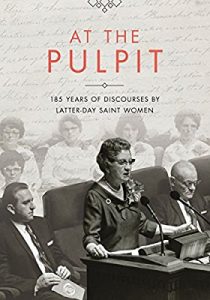Title: At the Pulpit: 185 Years of Discourses by Latter-day Saint Women
Author: Jennifer Reeder and Kate Holbrook, editors
Publisher: The Church Historian’s Press
Genre: Mormon Women’s History
Year Published: 2017
Number of Pages: 452, xxxi, appendix, notes, index
Binding: Hardcover
ISBN: 978-1629722825
Price: $29.99
Reviewed by Laura Compton for the Association for Mormon Letters
Mormon women’s voices have long been quietly tucked away, gathering dust in minute books and letters, occasionally appearing in organizational magazines or conferences. Only seldom have a few been used or referenced in public settings, partly because only have a few ever been easily accessible. That is no longer the case. Jennifer Reeder and Kate Holbrook have combed through nearly two centuries of women’s discourses, gathering representative speeches on dozens of gospel subjects, bringing 50 or so women’s voices to light and allowing them to once again inspire, uplift and teach audiences throughout the Church.
“At the Pulpit: 185 Years of Discourses by Latter-day Saint Women” is a long-awaited compilation of addresses by both prominent and not-so-prominent LDS women. Readers will surely recognize Lucy Mack Smith, Emma Smith, Eliza R. Snow, Belle S. Spafford or Sheri L. Dew and some of their more memorable talks and topics. They might not be as familiar with Lucrecia Suárez de Judrez or Jutte B. Busche, Emma N. Goddard or Amelia Flygare. Each had something important to say in her time, and each talk selected for inclusion in this work has something to say to 21st-century readers. Reeder and Holbrook’s biographical information about each woman, including pictures when available, provides those modern links to historical speech by contextualizing the women in time and place, tying their experiences to modern LDS experiences.
The biographical sketch for Drusilla D. Hendricks, for instance, explains how her life experiences during turbulent times in Missouri affected her faith, instilling a desire to rely on the Lord. This biographical information gives broader context to the remarks she shared with the Smithfield, Utah, Relief Society about her decision to allow her son to join the Mormon Battalion and why she described that decision in terms of Abraham’s sacrifice. The background provided by Reeder and Holbrook creates a poignancy to the story that deepens its meaning and broadens the reader’s understanding of Hendricks’ testimony.
As the editors note in their introduction, “While women’s discourses can be found throughout the Latter-day Saint historical record, these resources are often difficult to access.” (xxviii). Readers are indebted to Reeder and Holbrook for their excavations and the thorough job they did triple-checking transcripts by comparing them to original documents or digital images. This attention to detail ensured that the amplified women’s voices we are receiving are accurate representations of what was originally presented.
Each essay provides and important perspective into women’s experiences within the Church. The editors looked for “speeches that were well written, that contained theological analysis, and that illustrated women’s faith throughout the years since the church’s founding in 1830.” (xxix) The editors also made an effort to find women’s voices from places outside of Utah and its “Mormon Corridor.” Because of the nature of Mormon history, those non-central voices were particularly hard to find, but a small handful have been included in an effort to help address cultural, linguistic and experiential differences and variants on Mormon experiences.
A nine-page index makes it possible to search for some topics by subject, allowing readers to use “At the Pulpit” as a reference supplementing other LDS publications which have long been missing authoritative female voices on gospel topics. Thorough footnoting provides an additional help for readers wanting to follow up on particular subjects or addresses. A table containing “the names of all the women who have spoken” in General Conferences is also included, so readers wishing to find general discourses by women could review that table and find, for instance, that Belle S. Spafford spoke at the Aaronic Priesthood meeting in April 1947 or that Louise Y. Robison spoke in a general session in October 1929. While those talks are not included in this volume, Reeder and Holbrook have provided the guidance needed for readers to find those talks on their own.
“At the Pulpit” is a vital and important work which provides much-needed female insight, inspiration and voice. May its readers be inspired to find and use their own voices at the pulpit just as the speakers in this collection have done. There are many other women’s voices to be revived and heard again; Reeder and Holbrook have plotted a course for others to follow as well.

